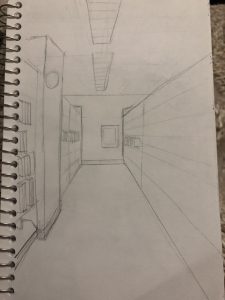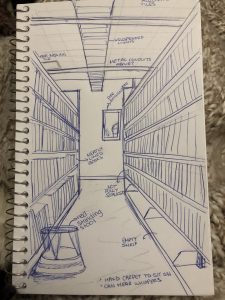Click Here for Midterm Presentation
Author Archives: Laurin Moseley
Site Report #2b – Laurin Moseley
Click Here for Site Report #2b – Brooklyn Collection and NYPL Map Division.
Site Report #2a – Laurin Moseley
Click Here for Site Report #2 – Brooklyn Collection and NYPL Map Division.
Site Report 1 – Laurin Moseley
Library Sketches 1 and 2
Post 2: Garnette Cadogan’s Due North Reflection
What city walking experiences do you have in common with the writer? What in your experience is different from what he wrote about? What do you think of the power of serendipity to “expose our commonalities,” as he puts it?
Recently, I visited the Murray Hill area and walked around Tudor City and Kips Bay. Arriving at 42nd Street – Grand Central Terminal was exciting and electric, even though it was a Sunday morning. Walking through Tudor City was peaceful and calm. There wasn’t the energetic and vibrant energy that Cadogan found in the Bronx, but there wasn’t a sense of exclusion from the residents as he described when he visited the Upper East Side. Like Cadogan, I met a local resident walking his dog on the East River Esplanade. He started talking to me about the history of the area and his experiences in Murray Hill area. He also suggested places I should visit in the area, and even walked me to the sculptor of SPOT (a 30-foot dalmatian dog balancing a taxi on his snout) on 34th Street.
I agree with Cadogan that the power of serendipity “exposes our commonalities”. By exploring the city and meeting individuals that we would have never met before, allows us realize that even though we all might live in a different zip code, we are all alike.
Post 1: The Rights to the City
Do people have a right to the city? Do longtime residents and businesses have a right to remain where they are? If so, how should local governments, urban planners, and other decision-makers ensure these rights are maintained?
Like Jane Jacobs, I believe that people have a right to the city they live in because they are the ones who reside their and give a city life. Without them, a city would be a ghost town. No energy, no feeling and no purpose.
Many longtime residents and businesses have spent decades building the businesses, communities and genuine neighborhoods that we love within the city. Even though change is inevitable, they have the right to remain where they are, without additional pressure, such as rent increase, forcing them out.
In the documentary “My Brooklyn”, we saw how the government, urban planners and other decision-makers dealt with the long-term locals when it came to the development of Fulton Mall. They didn’t care about what happened to them after they got permission to develop. They only saw the master plan for a new and prosperous area. Decision makers, urban planners and the government need to ensure that the rights of locals are met by listening to their concerns when new development projects are being proposed. They should not be evicting individuals from their business or home. However, they should take time to walk among the locals, experience the city like a they do and seeing the individuals that make up a community would help influence the design of a new development in an existing neighborhood that is more community-focused.





